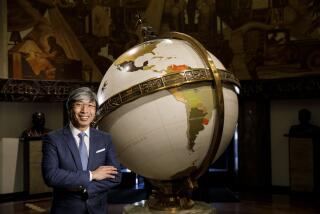The Los Angeles Times names Lewis D’Vorkin its new editor in chief
Los Angeles Times Publisher Ross Levinsohn wasn’t even a week into his search for a new top editor for The Times when he called Forbes Media’s top news executive, Lewis D’Vorkin. Levinsohn was startled when the veteran journalist immediately asked whether he was calling about the editor in chief job.
“You probably wouldn’t want to leave New York,” Levinsohn casually asked. D’Vorkin told him: “Don’t be so sure about that.”
The courtship sped up when D’Vorkin traveled to Los Angeles in late August to meet with Levinsohn and his deputy, Mickie Rosen. When the trio sat down for dinner, D’Vorkin was blunt: “I really want this,” he recalled telling them.
On Monday, D’Vorkin, 65, was named editor in chief of the Los Angeles Times. He plans to officially join Los Angeles Times Media Group on Nov. 1. Levinsohn also named Rosen, his deputy, as president of the Los Angeles Times Media Group.
“I have been training 40 years for this job,” D’Vorkin said Monday in a phone interview after the announcement.
D’Vorkin had been chief product officer for Forbes since 2010, and worked at numerous media outlets, including AOL, the Wall Street Journal, Newsweek and the New York Times. He was executive editor of Forbes from 1996 to 2000, then jumped to AOL when it was the biggest name in online media.
He then tried his hand as an entrepreneur, building an online publishing platform for journalists called True/Slant. One of its investors was a venture capital firm whose principals included Levinsohn. True/Slant was sold to Forbes in 2010.
He returned to Forbes and launched a plan to dramatically transform the 93-year-old magazine, which was reeling in the aftermath of the Great Recession.
Alongside the traditional in-depth articles produced by staff writers, D’Vorkin introduced online initiatives designed to save money and boost readership. That included paying outside contributors to write stories for Forbes.com, based on the number of readers they attracted. Advertisers were invited to pay to provide content for the site under the “BrandVoice” label.
D’Vorkin joins The Times at a turbulent time for journalism.
Readers are relying less on traditional sources for news, turning instead to Facebook, Twitter, Buzzfeed and Snapchat. And The Times has had its own share of drama, undergoing a series of ownership and management changes over the last two decades. Most recently, several top newsroom leaders were sacked in August, including Davan Maharaj, the editor and publisher.
Levinsohn, who replaced Maharaj in the publisher role, said in an interview that he considered 84 candidates for the top newsroom job.
“This was as important of a hire as I could make,” Levinsohn said. “It was important to find someone who had deep experience in journalism ... and also who had deep digital chops. He really remade Forbes, he has grown it dramatically.”
Forbes President Mike Federle, in an email to his staff to announce D’Vorkin’s departure, said the company was “grateful to Lewis for his bold ideas and the strong culture and foundation of innovation he helped create at Forbes over the past seven years.”
Forbes, Federle said, had become a “digital journalism powerhouse,” noting its site attracted 59 million unique visitors in August, up from 15 million in 2010.
“It’s all about digital, right?” said Douglas M. Arthur, a publishing analyst at Huber Research Partners in Greenwich, Conn. “Print is declining, and it will continue to decline.”
Arthur noted The Times has fallen behind its well-resourced East Coast rivals, including the New York Times, Wall Street Journal and Washington Post, which have used their national focus and in-depth reporting to build larger audiences. The Los Angeles Times has Sunday print circulation of 827,500, and 105,000 paid digital subscribers — double the number from a year earlier, but a fraction of the larger papers.
“When you look at the really great news organizations, the Los Angeles Times should be in that conversation,” Arthur said. He noted The Times has “all of the ingredients” as the largest news organization in the western U.S., with a vibrant hometown industry — Hollywood — a booming regional economy and close connections to Asia and Silicon Valley.
“You need someone who will ramp up the online digital platform and online subscriptions,” Arthur said. “You have to give people a reason to subscribe.”
D’Vorkin didn’t rule out an online strategy similar to Forbes’.
“I firmly believe the traditional reporting model is critical and I also believe there are other kinds of content creation models that can work,” he said. “New kinds of models are definitely important. New types of content models, new types of advertising models and new types of revenue models. All of these things are critical to the future success of the media organization.”
He said the key was “transparency” to make sure readers know the source of articles. He stressed that investigative and other forms of traditional journalism would remain “at the top of the pyramid.”
“Traditional reporting has never been more important than it is today and I believe in it to my core,” he said.
The New Jersey native said he was inspired to get into the news business by the work of Washington Post investigative reporters Bob Woodward and Carl Bernstein, who exposed Watergate. D’Vorkin said his father, who ran a used car parts business, wasn’t exactly thrilled, preferring that his son become an accountant — something more secure than journalism.
D’Vorkin earned his bachelor’s degree at the University of Iowa in journalism and economics.
“I’m a very methodical individual. I go step, by step, by step,” he said. “I have an expression: ‘Never try to boil the ocean’ because it doesn’t work. You do one thing at a time and all of a sudden it adds up to two, four, six and more.”
But, he said, he quickly made up his mind that he wanted to lead The Times’ newsroom after walking through its lobby, which features a revolving five-and-a-half-foot globe, set on a bronze pedestal, and 10-foot-high murals painted in 1935.
“Chills went up my spine,” he said. “This was the real deal.... How could I not be part of that history?”
Rosen, the other key executive named Monday, will help shape the strategy of Los Angeles Times Media Group as well as the digital shift across Times parent company Tronc.
Rosen has held positions at brands including Yahoo, Fox and Fandango and sits on the board of directors of streaming music giant Pandora Media and Fairfax Media in Australia. She most recently served as senior advisor to the Boston Consulting Group and was a partner and co-founder of advisory firm Whisper Advisors.
Interim editor Jim Kirk, who has been in charge of the newsroom since the shake-up in late August, will continue through the transition and, Levinsohn said in a memo, “possibly beyond.”
Times staff writer Ryan Faughnder contributed to this report.
ALSO
U.S. payrolls shrink for first time in 7 years: Hurricanes walloped job growth
FCC lets Alphabet try to use balloons to restore cell service to Puerto Ricans
Being harassed by Harvey Weinstein was ‘disgusting’ and ‘pathetic,’ TV reporter says
UPDATES:
7:20 p.m.: This article was updated with comments from an interview with D’Vorkin and a media analyst.
10:55 a.m.: This article has been updated with additional background on D’Vorkin and the announcement that Mickie Rosen will be joining the company as president of the Los Angeles Times Media Group.
This article was originally published at 10:05 a.m.







